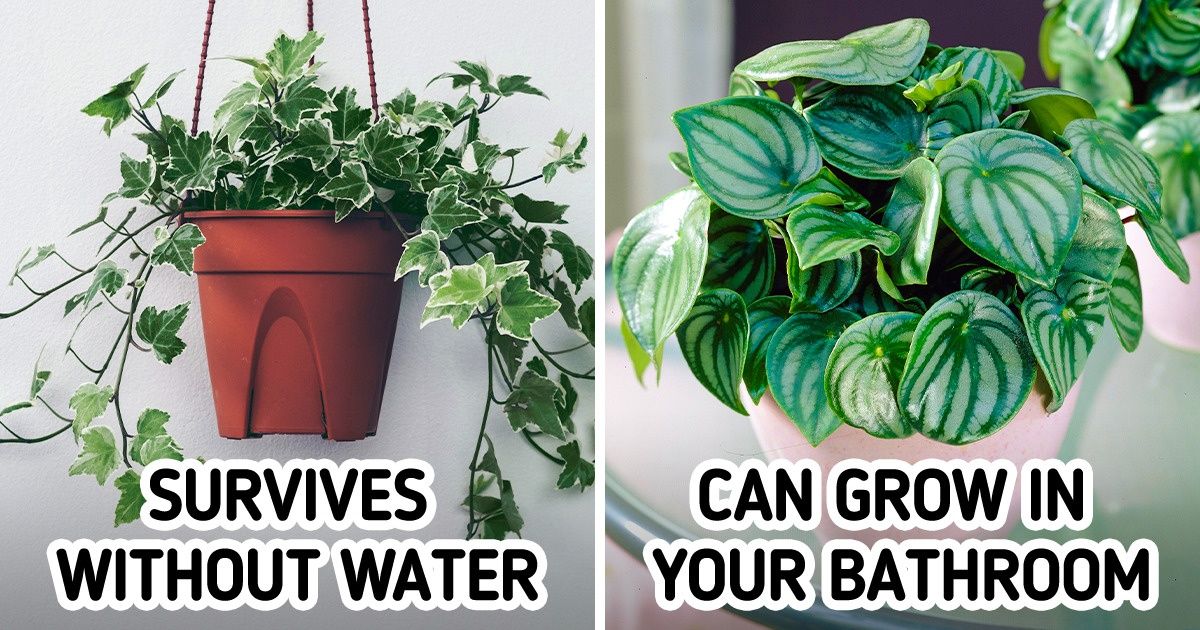15 Stories That Show Kindness Is the Quiet Power the World Often Forgets


If you have plants in your home, they can help purify the air, make it more humid, relieve allergy symptoms, and even improve mental health. But some of them can be a bit too high-maintenance, preventing us from getting one and making our homes greener. Luckily, there are plants that are super easy to take care of, and they still offer all the same benefits.
We at Bright Side can be a bit lazy sometimes, so we’re glad we can still make our homes look nice without having to do too much work.
Where to put it: Keep English ivy in a spot with medium to bright light.
Water: It can withstand drought, but it’s important to water it regularly and make sure it doesn’t stay wet for too long.
Problems: It rarely has pests or diseases, but sometimes there can be a problem with spider mites. It can be easily prevented, however, if you keep English ivy somewhere humid or cool. One more thing to be aware of is that English ivy is poisonous if you touch the sap or consume its leaves.
Where to put it: Jade plants should be kept in bright places. Young plants should stay in indirect sunlight, while older ones can handle more direct sunlight.
Water: During its growing season (spring and summer), it’s important to supply it with enough water. After that, wait until the soil is almost dried out before watering it again, which could be a week or even a month later. During its dormant season (fall and winter), the Jade plant needs even less water.
Problems: Diseases are very rare, but there can be a problem with mites and insects. Mealybugs are common, but you can just wipe them off with alcohol using a cotton ball.
Where to put it: Kalanchoes should be kept in a well-lit room.
Water: It can be damaged if you over-water it, so make sure the soil is dry enough before watering. Usually, that would mean doing it about once a week.
Problems: Diseases are rarely a problem. However, pests like mealybugs, aphids, and brown scale could become an issue. Simply scrape off the brown scale and remove aphids by hand.
Where to put it: Make sure to keep the peperomia out of direct sunlight.
Water: Peperomia plants prefer humid places, so you can even grow them in your bathroom, but they will do just as well in any other room in the house. Keep the soil on the drier side, as it doesn’t require frequent watering. Once every 7-10 days will be enough.
Problems: Peperomia plants are resilient when it comes to pests, but they can sometimes be affected by fungus gnats, mites, and mealybugs.
Where to put it: Chinese evergreens do well in medium to low light spots, out of direct sunlight, so you can even keep them in a room with no windows.
Water: Keep the soil moist by regularly watering it, but make sure it’s not soggy and let the soil dry out a bit before waterings.
Problems: Diseases are not very common, but sometimes Chinese evergreens can be affected by mites and insects.
Light: Keep your ficus plant in a bright room, but out of direct sunlight.
Water: You can water it once every 1-2 weeks. Make sure that the soil doesn’t dry out completely between waterings and that it stays a bit moist.
Problems: Ficus are prone to foliar fungal infections. Spider mites and mealybugs can also be a problem, but you can simply wipe them off and use sprays.
Where to put it: Ponytail palms like sunlight, so you can place yours near a window.
Water: In summer, you don’t have to water it very often, but make sure you water it deeply and let the soil dry out after. In winter, you’ll need to water it even less often.
Problems: Look out for spider-like webbing and spider mites. To deal with them, rub a cloth of dish soap and water over the stems.
Where to put it: Keep cast-iron plants away from direct sunlight, which could cause scorch marks on the leaves.
Water: Cast-iron plants are tolerant of drought, but make sure to water it thoroughly in spring and summer, allowing the soil to dry between waterings. In fall and winter, water it less frequently.
Problems: Sometimes brown or black spots might appear on the leaves, so you’ll need to remove them and use a fungicide. Cast-iron plants can also be affected by mealy bugs, scale insects, and spider mites.
Where to put it: Keep your pothos in a bright place, but out of direct sunlight, otherwise it will burn and bleach out. It can also tolerate very low light conditions.
Water: Don’t over-water your pothos, but make sure the soil stays moist, allowing it to dry out slightly between waterings.
Problems: Pest infestation is rare, but mealybugs can sometimes be a problem.
Where to put it: You can place your corn plant near a window where there’s enough light. However, make sure to keep it out of direct sunlight.
Water: During the growing season, keep the soil slightly damp. In winter, water it less often, keeping the soil on the drier side, but not dried out completely.
Problems: Corn plants can sometimes be affected by spider mites and a few other insects.
Where to put it: Keep your arrowhead vine in places with medium to low light. Bright light could also work, but make sure not to keep it there too long. Variegated types can handle more direct sunlight.
Water: The arrowhead vine prefers moist soil, but make sure it’s not too soggy. Once the soil starts to dry, it’s time to water it again. In winter, water it less frequently but don’t let it dry out.
Problems: Pests are usually not a problem, but it could be attacked by spider mites, mealybugs, and some other insects.
Where to put it: Put your spider plant in a bright spot, but make sure there’s no direct sunlight. It can also grow in low sunlight, but slower.
Water: Keep the soil moist. After watering, check it after 4-5 days. If it’s dry, it’s time to water it again.
Problems: Usually spider plants are pest-free, but they can sometimes be affected by spider mites, scales, and aphids. However, they can be prevented by good air circulation, adequate water, and bright light.
Where to put it: Keep your ZZ plant in a bright room, but out of direct sunlight. It can also tolerate low light.
Water: Water it thoroughly and let the soil dry out before watering again. It can handle dry soil for a while, but if you leave it like that for too long, it will drop its leaves.
Problems: The ZZ plant is almost completely resistant to pests and diseases. Diseases might appear only if you water it too much or keep it in a very humid place. ZZ plants can also be infested by aphids, but it’s very rare. You should also keep in mind that it’s poisonous if you eat or chew it.
Where to put it: Philodendrons like moderate to bright light. Make sure not to put them in direct sunlight though.
Water: Keep the soil slightly moist throughout the year, except for winter. In winter, let the surface dry out.
Problems: Philodendrons are usually pest-free, but they can become infested with aphids, mealybugs, scales, and spider mites.
Where to put it: Keep your snake plant in bright but indirect sunlight. If you keep it in a more shaded spot, it will also be fine, although, it might grow a bit slower and lose its bright color.
Water: The snake plant tolerates drought very well. Don’t water it a lot, and make sure the soil is not too moist. During the summer, water the plant as soon as it dries out. During the winter, you can leave it dry for longer periods of time.
Problems: Snake plants might have some insect infestations or fungal problems.
Which plant would you bring home with you? What plants do you already have? Are they easy to take care of?











